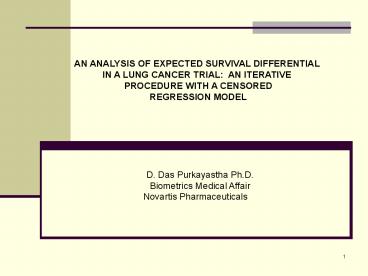AN ANALYSIS OF EXPECTED SURVIVAL DIFFERENTIAL PowerPoint PPT Presentation
1 / 16
Title: AN ANALYSIS OF EXPECTED SURVIVAL DIFFERENTIAL
1
AN ANALYSIS OF EXPECTED SURVIVAL DIFFERENTIAL IN
A LUNG CANCER TRIAL AN ITERATIVE PROCEDURE
WITH A CENSORED REGRESSION MODEL
D. Das Purkayastha Ph.D. Biometrics Medical
AffairNovartis Pharmaceuticals
2
- OUTLINE
- Introduction
- Model
- Definitions
- Estimation
- Iteration Procedure for Computation
- Data
- Analysis
- Results
- Conclusion
- References
3
- INTRODUCTION
- An alternative look at the analysis of expected
survival differential - A latent variable framework with a differential
threshold of survival time with or without
disease - to maximize the probability of survival
differential - A standard censored regression model
- Two regimes are considered in the model with a
switching criterion for above and below a
pre-assigned threshold level of the expected
survival differential - EM algorithm
- Lung cancer data (publicly available) from a
randomized Phase III clinical trial - Treatment of locally advanced non-small cell lung
cancer - Comparison between the stand-alone use of
radiotherapy and a combination therapy
4
(No Transcript)
5
(No Transcript)
6
(No Transcript)
7
(No Transcript)
8
(No Transcript)
9
(No Transcript)
10
(No Transcript)
11
- ANALYSIS
- The above iteration procedure was used for
computation of parameters in the model - SAS IML
- ? 0.4 tolerance limit from .0001 to .01
(recommended) - convergence issues ? .8, .9.
- The model was estimated for each treatment group.
12
(No Transcript)
13
(No Transcript)
14
- Results from LCSG (1988)
- There is statistically significant difference for
recurrence of disease and recurrence rate between
radiotherapy and combination therapy within one
year (p - Death rate within one year was significantly
different between the therapies (p .02). - Log rank test also showed statistically
significant difference in time to recurrence of
the disease. - Current findings
- It is interesting to note that in this paper
survival difference does not have statistically
significant effect of recurrence rate. - The results shown in Table 2 show that cell type,
tumor status, recurrence, weight loss or age have
no statistical impact on the survival difference
of the each and overall treatment groups. - Only the therapy type in the overall model shows
statistical significance (p .026) on the
survival difference (di).
15
- It is well known that such models need
comparatively larger observations. Also,
sometimes to achieve convergence was difficult or
not possible. Thus, it is imperative that the
results of the overall model as depicted in Table
2 should be cautiously interpreted. - CONCLUSIONS
- It facilitates the applications of such censored
regression models for survival analyses. - Empirically, the results of the overall model
show that the type of therapy (radiotherapy, or
combination therapy) as used on cancer patients
can have a statistically significant effect on
the survival time differential. But it needs
cautious interpretations of the results. - This model needs comparatively larger patient
population to draw valid inference from the
results. For small samples size, it is also
computationally difficult. However, it provides
an alternative look at survival analysis.
16
REFERENCES AMEMIYA, T. (1973) Regression
Analysis When the Dependent Variable is
Truncated Normal Econometrica 41
997-1016. BLIGHT, J.N. (1970) Estimation From a
Censored Sample for the Exponential Family,
Biometrika 57(2) 389-395. COHEN, A.C. (1957)
On the Solution of Estimating Equations for
Truncated and Censored Samples from Normal
Populations Biometrika 44 225-261. DEMPSTER,
A.P., LAIRD, N.M., and RUBIN, D.B. (1977)
Maximum Likelihood f rom Incomplete Data via the
E.M. Algorithm Journal of the Royal Statistical
Society (series B) 39 1-38. FAIR A note on the
Computation of the Tobit-Estimator Econometrica
45(7) 1723-1730. LUNG CANCER STUDY GROUP(1988)
The Benefit of Adjuvant Treatment for
Restricted Locally Advanced Non-Small-Cell Lung
Cancer, Journal of Clinical Oncology, Vol 6, 1
(January) 9-17. MADDALA, G.S. (1987) Limited
Dependent and Qualitative Variables in
Econometrics Cambridge University
Press. PIANTADOSI, S. (1997) Clinical Trials A
Methodologic Perspective John Wiley Sons,
Inc. New York.

